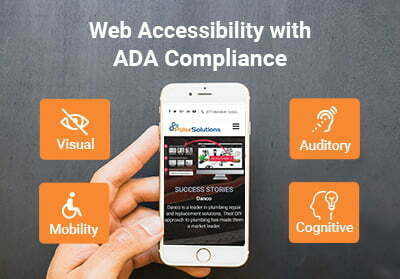
Many Pulse web systems are designed from the ground up to be ADA compliant, our web engineering teams specialize in meeting and exceeding ADA compliance regulations. If you have a website that needs to be built or a site that needs to meet ADA compliance guidelines get in touch with a Pulse representative.
In 2018, one of the biggest trends in the website development space is the inclusion of American Disabilities Act (ADA) compliance. To learn more about the necessity of ADA compliance, let’s try a small experiment. Launch your browser, find your favorite website, and close your eyes and ears with your hands. Now, try to navigate your website and find the information you are looking for on that website. You will perhaps find it impossible to find what you are looking for. This is the obstacle millions of people with disabilities face every day.
The United States Census Bureau states that more than 50 million Americans have a disability, making up to nearly 20 percent of the U.S population. And that’s just in the United States.
Now, think about if one in every five customers cannot access your website, how much revenue you lose? That’s why it’s critical to understand how beneficial ADA compliance is for your website.
ADA compliance has many benefits. It gives you a competitive advantage, offers a better overall experience across browsers, provides digestible information for Google and other search engine results, helps the site reach a wider audience and reduces the likelihood of ADA litigation.For most organizations, the most critical thing to consider is your website’s accessibility and ensure you are not limiting access to your website content. Consumers are today committing their money and loyalty to companies that pledge to demonstrate inclusion of people with disabilities. You have the opportunity to serve this market and earn their loyalty by offering a superior experience to users with disabilities.
So, what are the benefits of an accessible website?
Improve usability for all types of visitors
In the course of implementing web accessibility best practices, you will discover that many ADA compliance requirements also improve usability for everyone. ADA compliance helps users in a variety of situations:
- In a room with bright sunlight or glare on the screen
- In a car, when visual attention is limited
- In emergencies
- In a noisy room
- In a dark room or at night
In a nutshell, basic accessibility is a prerequisite for usability.
Accessible and Universal Design
Universal design extends design principles to include the needs and wants of people whose mental, physical, or environmental conditions limit their performance and include people of all ages and abilities. Adopting accessible and universal design principles benefits everyone, and studies have shown that it makes accomplishing web tasks simple for everyone. The benefits include:
- Reducing fatigue
- Increasing speed
- Decreasing errors
- Faster learning times
SEO Benefits
It might be surprising, but you will very likely see improved SEO rankings when you design your website to be ADA compliant. Your ADA Site compliance reports successfully identify website issues that affect the ability of search engines to index your website effectively. On implementing recommended changes, your business will benefit from more increased sales conversion and more traffic to your website.
Improved ROI
As many disabled users who were unable to navigate your website earlier, can now access it successfully, it results in increased ROI with the potential to increase your sales by over 20%. The market segment of customers with a disability is very loyal to organizations that make committed efforts to improve their quality of life – opportunity for your business to win a fiercely loyal revenue stream.
What makes a website ADA compliant?
While many design features go into developing an ADA compliant website, below are some key areas that business needs to focus:
- Resizable text with a high contrast mode option to make text easier to read for sight-impaired users
- Photos with text descriptions for external reader devices, ensuring that sight-impaired visitors can interpret the website content
- PDF documents with a proper tag so that screen readers can accurately understand the non-HTML content
- Videos with audio descriptions and transcripts for people who have a hearing disability
- Keyboard accessibility for users with limited motor skills.
By adopting ADA compliant website, you can enhance the web experience for all your users through superior customer service, better SEO, and apply best practices in usability and universal design. Contact us to learn how you can make your website ADA compliant today.
